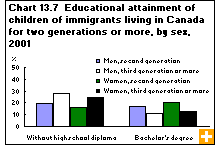Common menu bar links
Children of immigrants doing well
Archived Content
Information identified as archived is provided for reference, research or recordkeeping purposes. It is not subject to the Government of Canada Web Standards and has not been altered or updated since it was archived. Please contact us to request a format other than those available.
Second-generation Canadians are doing well—many are doing better than third-generation Canadians—according to a study of people who were born in Canada to at least one immigrant parent. In general, second-generation Canadians are more educated and earn more on average than Canadians of a similar age whose parents were both born here.
Second-generation Canadian men born from 1964 to 1976 are more likely to hold a university degree than Canadians of the same age whose parents were born in Canada. They also have an earnings advantage—about 6% higher average weekly earnings in 2000—except if their father was born in the Caribbean, Central America, South America or Oceania; those second-generation Canadian men had earnings 14% below the average. On the other hand, if his father came from North America, Northern or Western Europe, the second-generation man’s earnings were 14% above the average.
The picture is similar for second-generation Canadian women, except a father’s country of birth has less impact on his daughter’s education level or earnings. These women earned on average just over $27,000 in 2000, whereas women with two Canadian-born parents made less than $25,000. Women with Asian-born fathers earned 27% above the average, while women with African-born fathers had an earnings advantage of 26%.
In 2001, more than one-third of Canadians aged 16 to 65 were immigrants or the children of immigrants. About 7% were second-generation Canadians with both parents born in another country, while a further 7% to 8% had one parent who was born outside Canada.



